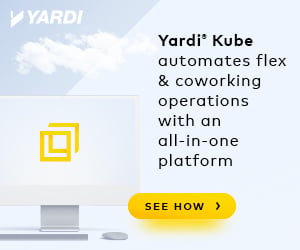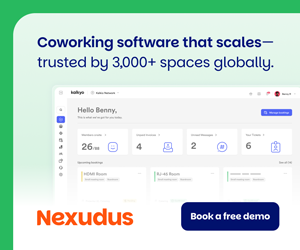
The Real Reason Coworking And Flex Spaces Struggle To Make Money
- Most coworking operators underestimate hidden costs like staff time, travel, and legal fees, which quietly erode profitability.
- Services like coffee and meeting rooms often lose money unless priced with full cost awareness, including labor and overhead.
- Integrated tech systems streamline operations, cut waste, and give operators the visibility needed to run a truly profitable business.
The flex and coworking space industry is a sector full of opportunity, but also packed with challenges that often leave operators struggling to turn a profit.
From my years working closely with operators, I’ve seen that while many are caught up in the day-to-day hustle, few have the full picture of what really drives their bottom line, and that’s where technology can make all the difference.
Advertisements

Why Are Operators Struggling?
It’s tempting to think that providing shared office space is straightforward: rent out desks, charge membership fees, maybe sell some extras like coffee or meeting rooms. But the reality is far more complex.
Operators spend significant time juggling multiple systems (booking platforms, billing software, customer management, legal compliance tools) and often, this scattered approach drains resources faster than revenue can replenish them.
Advertisements

For example, services like meeting rooms, coffee, snacks and WiFi are essential perks for members, but rarely generate profit. They’re usually sold at break-even or even at a loss, yet operators must provide them to stay competitive.
This raises a crucial question: how do you price these services fairly and make a profit? You need to factor in not only direct costs but also indirect overheads such as staff time spent managing orders, inventory, and customer requests.
The Hidden Costs of Manual Workflows
Flexible workspace operators often face operational drain in ways that aren’t always visible on the balance sheet. Some of the most impactful inefficiencies include:
- Manual sales responses: Every inquiry often requires a hand-prepared response, which leads to delays, inconsistent messaging, and a higher likelihood of human error.
- Time lost securing documentation: On average, a sales manager can take up to 3–4 hours to collate all information and finalize a proposal or due to manual coordination, follow-ups, and lack of standardized templates. Similarly, when a proposal is accepted, turning that into a contract takes another couple of hours. These could just be automated and all done in 5 minutes with a good CRM.
- Disjointed processes: Sales follow-ups, viewing schedules, confirmation emails, proposals, legal contracts, billing, reporting, and interaction with members are frequently handled across multiple platforms, MS/Google Docs and spreadsheets — increasing the risk of mistakes, delayed response and missed opportunities.
- Scattered data: Without a centralized CRM, key sales and client information lives in email threads, shared drives, or outdated disparate systems, thus slowing down follow-ups and reporting.
- Under-negotiated services: Operators often don’t have time to revisit insurance policies, vendor contracts, or recurring expenses, leading to higher costs over time.
- Travel and coordination overhead: In-person meetings, site inspections, and vendor visits all chip away at staff time and productivity.
Beyond these, operators often underestimate hidden costs such as the time staff spend managing seemingly minor tasks that add up significantly over weeks and months. These hidden operational expenses quietly erode profitability if left unchecked.
Advertisements

Where Does Technology Fit In?
Technology is the backbone of efficiency and profitability in this industry. The key lies in integrating all operational aspects into a seamless workflow, from lead management to proposal and contract generation, billing, and customer communication. When these systems talk to each other, operators save valuable time, reduce errors, and improve customer experience.
Visibility is another critical element. Operators must have real-time insight into occupancy rates, revenue streams, service costs, and customer engagement. Without this, they’re flying blind by making decisions based on guesswork rather than actual data.
I’ve seen firsthand that tech-enabled processes can transform dull, demotivating operations into lean, efficient, and profitable businesses. It’s no coincidence that the most successful operators invest heavily in technology solutions tailored to their needs.
The Profitability Equation: Maximizing Revenue While Minimizing Costs
Ultimately, like any other business, the profitability of coworking and flex space hinges on two sides of the equation: maximizing revenue streams and minimizing expenses.
Maximizing Revenue Streams
- Accelerate lead-to-deal conversion by automating the sales process and removing manual bottlenecks.
- Boost private office occupancy through competitive, tiered pricing models, including introductory free periods and flexible packages tailored to SMEs and startups.
- Mitigate occupancy risk by avoiding overreliance on large, single-client deals. Focus instead on attracting a diverse base of small and medium-sized enterprises.
- Upsell premium, value-added services to existing members, such as IT support, mail handling, or enhanced privacy options.
- Increase meeting room usage with online booking, value-added offerings (e.g., catering, A/V support), and local promotions or time-limited discounts.
- Monetize unused space after hours by hosting evening events in coworking lounges. Partner with local caterers to eliminate in-house costs while earning a healthy markup.
- Retain loyal customers by offering flexible renewal terms that serve both parties, and by maintaining consistently high satisfaction levels.
- Appeal to eco-conscious tenants with sustainable design, green certifications, and environmentally friendly services.
Minimizing Costs
- Eliminate manual tasks by automating operations through smart building technologies and management platforms.
- Negotiate favorable lease terms by maintaining strong landlord relationships and leveraging data on occupancy trends and usage.
- Lower utility bills by investing in energy-efficient systems and smart consumption monitoring.
- Renew client contracts proactively to avoid costly broker acquisition fees.
- Equip staff with efficient tools that allow a lean team to handle more tasks effectively.
- Automate KPI reporting to save management time and ensure real-time visibility into performance.
- Optimize purchasing strategies by bulk ordering across multiple locations or outsourcing services to reduce in-house overhead to zero.
The Path Forward
The flex and coworking space industry isn’t inherently unprofitable. With the right combination of technology and strategic management, every operator can improve their margins and build a sustainable business. The fast pace of the industry demands that operators work smarter—not harder.
By investing in tech-driven automation, integrating workflows across sales, legal, operations, and finance, and gaining real-time visibility into performance metrics, operators can reduce overhead, speed up processes, and focus on delivering value.
Summary: What Makes a Coworking Operator Profitable?
- Maximize space utilization and occupancy through competitive, tiered pricing and targeting the right clients
- Offer premium and bespoke services that enhance customer value
- Host community and networking events to build engagement and additional revenue
- Partner with local businesses and corporates to grow the tenant base and long term members
- Deploy scalable, integrated technology infrastructure to automate workflows and centralize data
- Eliminate duplication by standardizing business procedures and automating manual tasks
- Increase operational efficiency through better tools and process visibility
- Identify and reduce hidden costs, including staff time, utilities, and poorly managed contracts
By focusing on these core areas and embracing technology, coworking space operators can turn complexity into opportunity, and build profitable yet sustainable businesses.
Advertisements


